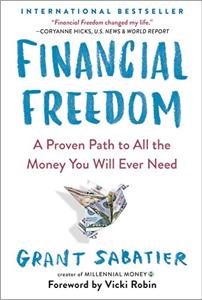
Want to learn the ideas in Financial Freedom better than ever? Read the world’s #1 book summary of Financial Freedom by Grant Sabatier here.
Read a brief 1-Page Summary or watch video summaries curated by our expert team. Note: this book guide is not affiliated with or endorsed by the publisher or author, and we always encourage you to purchase and read the full book.
Video Summaries of Financial Freedom
We’ve scoured the Internet for the very best videos on Financial Freedom, from high-quality videos summaries to interviews or commentary by Grant Sabatier.
1-Page Summary of Financial Freedom
Overview
Millennials, such as Grant Sabatier, are trapped in cubicles and can’t make ends meet. They’re overwhelmed by debt and don’t know how to get ahead financially. This is exactly how Sabatier felt when he was 24 years old. He struggled for five years until he achieved financial freedom at 29 by developing a strategy that would allow him to be free of needing a job ever again. In this article we’ll explore his strategy so you can do the same thing with your own life. We’ll discuss Einstein’s view on wealth; why budgets aren’t helpful in creating wealth; and how one millennial will become a millionaire from $5 dog-walks.
Big Idea #1: To reach financial freedom, you have to defy social norms.
The author of the passage was at a low point in his life. He had been working for several years and had little to show for it. In August 2010, he was unemployed and living with his parents.
When Grant calculated his income and expenses, he realized why it was so hard to save money. Millennials earn less than half of what their parents did, have student loan debts to pay off on top of that, and inflation is a factor as well.
Even if Grant followed the typical 9 to 5 job for 40 years, he wouldn’t have been able to retire comfortably. He realized that in order to reach financial freedom, he would need to do something different from what everyone else was doing and follow his own path.
On a certain day in 2010, he decided that it was time to stop working at his job and start living the life he’d always wanted. He knew what kind of life he wanted, but it would take a lot of money to be able to retire early. In order for him to save $1,250,000 by age 40 (which is when most people are retiring), he had to break out of the mold that society put on people his age.
Grant started out by learning as much about finance as he could. He realized that money wasn’t finite, but rather a tool to be used for generating more wealth. Armed with this new knowledge, Grant developed a plan to achieve his goal of saving $1 million by the time he was 35 years old. His plan involved working full-time and starting two side businesses while investing in stocks. It was demanding, but it paid off when Grant reached financial freedom within five years.
You can achieve financial freedom by following Grant’s strategy. It will take hard work and commitment, but you’ll be able to live your life the way you want without worrying about money.
Big Idea #2: The first step toward financial freedom is to calculate how much money you spend annually.
Einstein is quoted as saying that compounding is one of the wonders of the world. Compounding allows your money to grow over time, even if you don’t add any more money to your account. This happens because every dollar in your account generates interest, and that interest then earns its own interest.
The author Grant decided to save $1,250,000 because he needed that much money in order to live comfortably. He figured out how much money he would need every year and then used that amount as the basis for calculating his savings target.
The key message here is: The first step toward financial freedom is to calculate how much money you spend annually. Each of us has a unique vision of how we want to live our lives, so there’s no universal number that can be used as a target for savings. To figure out your savings target, start by looking at all the ongoing expenses you have in a year, like rent or mortgage payments, taxes, utilities and insurance. Then factor in any future plans you might have such as having kids or moving to an expensive neighborhood.





